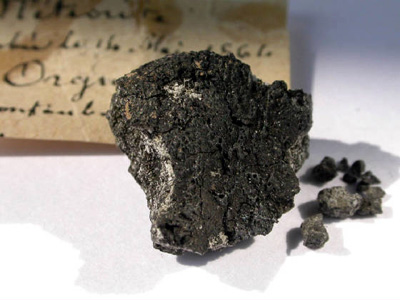Orgueil

A large carbonaceous Ivuna-like (CI1) chondriteChondrites are the most common meteorites accounting for ~84% of falls. Chondrites are comprised mostly of Fe- and Mg-bearing silicate minerals (found in both chondrules and fine grained matrix), reduced Fe/Ni metal (found in various states like large blebs, small grains and/or even chondrule rims), and various refractory inclusions (such Click on Term to Read More that disintegrated and fell in fragments near the French town of Orgueil on May 14, 1864. About 20 pieces, totaling ~12 kg in mass, were subsequently recovered from an area of several square km, some head-sized but most were smaller than a fist. Specimens could be cut with a knife and, when sharpened, pieces could be used like pencils.
In 2001, researchers found that a pristine piece of the interior of Orgueil contained a relatively simple mixture of amino acids, consisting primarily of glycine and β-alanine. They also analyzed the sample’s carbonElement commonly found in meteorites, it occurs in several structural forms (polymorphs). All polymorphs are shown to the left with * indicating that it been found in meteorites and impact structures: a. diamond*; b. graphite*; c. lonsdalite*; d. buckminsterfullerene* (C60); e. C540; f. C70; g. amorphous carbon; h. carbon nanotube*. Click on Term to Read More isotopeOne of two or more atoms with the same atomic number (Z), but different mass (A). For example, hydrogen has three isotopes: 1H, 2H (deuterium), and 3H (tritium). Different isotopes of a given element have different numbers of neutrons in the nucleus. Click on Term to Read More concentration and found that the amino acids were not derived from Earthly contamination but instead were almost certainly synthesized chemically in space. The research team then compared their results with three other meteorites: Murchison and Murray, which have been studied extensively, and Ivuna, a meteoriteWork in progress. A solid natural object reaching a planet’s surface from interplanetary space. Solid portion of a meteoroid that survives its fall to Earth, or some other body. Meteorites are classified as stony meteorites, iron meteorites, and stony-iron meteorites. These groups are further divided according to their mineralogy and Click on Term to Read More that fell in Tanzania, Africa, in 1938, that had not been analyzed for amino acids. The team broke the meteorites down into two classes.The Murchison and Murray meteorites were placed in a category containing a complex mix of amino acids made up of more than 70 different types of amino acids. Orgueil and Ivuna, however, were categorized with a much simpler composition made up primarily of just two amino acids.
Murchison and Murray are widely believed to be pieces of an asteroid, as are virtually all meteorites scientists have studied. However, Orgueil and Ivuna show evidence that they are derived from a cometConglomeration of frozen water and gases (methane, ammonia, CO2) and silicates that that formed in the outer solar system and orbits the Sun. In recent years, the description of comets has shifted from dirty snowballs to snowy dirtballs with more dust than ice. However, the ratio is less than 10-to-1. Click on Term to Read More. The amino acidA small molecule containing and amine group (–NH2) at one end and a carboxylic acid group (–COOH) at the other. They link up with various other amino acids to form proteins. Because they are used to build proteins, most of the human body consists of amino acids with their abundance second Click on Term to Read More signatures within Orgueil and Ivuna suggest that these compounds were likely synthesized from components such as hydrogenLightest and most common element in the universe (~92% by atoms; ~75% by mass). Hydrogen's isotopes are: • 1H (99.9885 %)
• 2H (0.0115 %), also called deuterium.
• 3H, also called Tritium, is a radioactive (t½ = 12.32 y) by-product of atmospheric thermonuclear tests in Earth's hydrosphere and atmosphere.
Click on Term to Read More cyanide, which have been recently observed in the comets Hale-Bopp and Hyakutake. This suggests that the organicPertaining to C-containing compounds. Organic compounds can be formed by both biological and non-biological (abiotic) processes. Click on Term to Read More material in Orgueil and Ivuna is the product of reactions that once took place in the nucleusCore of an atom, where nearly the entire mass and all positive charge is concentrated. It consists of protons and neutrons. Click on Term to Read More of a comet, which, if true, would make these meteorites the first to be identified as having come from a comet nucleus.
Some or all content above used with permission from J. H. Wittke.






